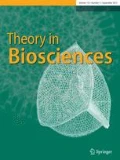Abstract
Topological features evolved from genetic operators in the recombination space play a crucial role in the course of evolution. Different crossover models generated in a recombination space can be structured by pretopological space. This paper deals with several types of connectedness properties of recombination space in three different cases of unequal crossover of recombination space structured as pretopology. It is shown that unrestricted unequal crossover is one-sidedly connected and consequently hyper-connected, apo-connected and connected as well. Restricted unequal crossover is hyper-connected and connected. Unequal sister chromatid exchange is connected.
Similar content being viewed by others
References
Adams C, Franzosa R (2008) Introduction to topology pure and applied. Pearson Prentice Hall, Englewood Cliffs
Alexandroff P (1937) Diskrete raume. Mat Sb (NS) 2:501–518
Ali T (2011) Modelling RNA evolution. In: Proceeding of WASET conferences Paris
Ali T, Phukan CK (2011) Fuzzy proximity in phenotype space. Int J Adv Comput Math Sci 2:117–125
Ali T, Phukan CK (2012) Incompatibility of metric structure in recombination space. Int J Comput Appl 43(14):1–6
Arenas FG (1999) Alexandroff spaces. Acta Math Univ Comenianae 68:17–25
Axelrod DE, Baggerly KA, Kimmel M (1994) Gene amplification by unequal sister chromatid exchange: probabilistic modeling and analysis of drug resistance data. J Theor Biol 168:151–159
Belmandt ZT (1993) Manuel de prétopologie et ses applications. Hermès, Paris
Čech E (1966) Topological spaces. Wiley, Hoboken
Cupal J, Kopp S, Stadler PF (2000) RNA shape space topology. Artif Life 6:3–23
Dalud-Vincent M, Brissaud M, Lamure M (2011) Connectivities and partitions in a pretopological space. Int Math Forum 6(45):2201–2215
Fontana W, Schuster P (1998) Continuity in evolution: on the nature of transition. Science 280:1451–1455
Gastl GC, Hammer PC (1965) Extended topology. Neighborhoods and convergents. In: N.N., editor, Proceedings of the colloquium on convexity 1965, pp 104–116, Copenhagen, DK, 1967. Kobenhavns Univ. Matematiske Inst
Gitchoff P, Wagner GP (1996) Recombination induced hypergraphs: a new approach to mutation-recombination isomorphism. Complexity 2:37–43
Gnilka S (1994) On extended topologies. I: closure operators. Ann Soc Math Pol Ser I Commentat Math 34:81–94
Kruger J, Vogel F (1975) Population genetics of unequal crossing over. J Mol Evol 4:201–247
Kuratowski C (1949) Sur la notion de limite topologique d’ensembles. Ann Soc Polon Math 21:219–225
Mynerd F, Seal GJ (2010) Phenotype spaces. J Theor Biol 60:247–266
Shpak M, Wagner GP (2000) Asymmetry of configuration space induced by unequal crossover: implications for a mathematical theory of evolutionary innovation. Artif Life 6:25–43
Stadler BMR, Stadler PF (2002) Generalized topological spaces in evolutionary theory and combinational chemistry. J Chem Inf Comput Sci 42:577–585
Stadler BMR, Stadler PF (2004) The topology of evolutionary biology. In: Ciobanu IG, Rozenerg G (eds) Modelling in molecular biology. Springer, Berlin, pp 267–286
Stadler P, Stadler B (2006) Genotype phenotype maps. Biol Theory 3:268–279
Stadler PF, Wagner GP (1998) The algebraic theory of recombination spaces. Evol Comput 5:241–275
Stadler PF, Seitz R, Wagner GP (2000) Evolvability of complex characters: population dependent Fourier decomposition of fitness landscapes over recombination spaces. Bull Math Biol 62:399–428
Stadler BMR, Stadler PF, Wagner G, Fontana W (2001) The topology of possible: formal spaces underlying patterns of evolutionary change. J Theor Biol 213:241–274
Stadler BMR, Stadler PF, Shapk M, Wanger GP (2002) Recombination spaces, metrics, and pretopologies. Z Phys Chem 216:217–234
Stong RE (1966) Finite topological spaces. Trans AMS 123:325–340
Wagner G, Stadler PF (2003) Quasi-independence, homology and the unity of type: a topological theory of characters. J Theor Biol 220:505–527
Willard S (1970) General topology. Addison Wesley Publishing Co., Boston
Author information
Authors and Affiliations
Corresponding author
Additional information
Publisher's Note
Springer Nature remains neutral with regard to jurisdictional claims in published maps and institutional affiliations.
Rights and permissions
About this article
Cite this article
Phukan, C.K. Connected pretopology in recombination space. Theory Biosci. 139, 145–151 (2020). https://doi.org/10.1007/s12064-019-00304-3
Received:
Accepted:
Published:
Issue Date:
DOI: https://doi.org/10.1007/s12064-019-00304-3




